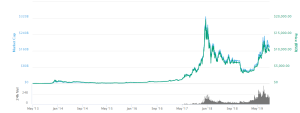Bitcoin’s Price Journey in 2016: A Comprehensive Analysis
Relive the rollercoaster year of Bitcoin in 2016! Explore the dramatic price fluctuations, technological breakthroughs, and regulatory hurdles that shaped the crypto landscape. Uncover the wild ride that defined a pivotal year in Bitcoin history!
The year 2016 presented a fascinating case study in the volatile world of cryptocurrency. Bitcoin, still relatively young and largely unknown to the mainstream, experienced significant price swings throughout the year. These fluctuations were driven by a complex interplay of technological advancements, regulatory uncertainty, and burgeoning public interest. Understanding the dynamics of the Bitcoin price in 2016 offers valuable insights into the cryptocurrency market’s inherent unpredictability and its potential for both explosive growth and dramatic corrections. This comprehensive analysis will delve into the key events and trends that shaped Bitcoin’s price journey during that pivotal year.
The State of Bitcoin in Early 2016
At the beginning of 2016, Bitcoin was trading at a relatively modest price, hovering around $430. This followed a period of considerable price decline from its previous peak. The cryptocurrency community, while enthusiastic, remained small and largely comprised of tech-savvy individuals and early adopters. News coverage was minimal, and regulatory frameworks were still in their nascent stages. The lack of widespread understanding and the volatile nature of the market contributed to a climate of cautious optimism.
Technological Developments and Community Growth
Despite the relatively low price, significant technological developments were underway. The Bitcoin network continued to improve its scalability and security. This period saw the continued development and refinement of various Bitcoin wallets and exchanges, making the cryptocurrency more accessible to a wider audience. The growing community fostered innovation, with the emergence of new services and applications built on the Bitcoin blockchain.
The development of various altcoins also began to gain traction, introducing alternative blockchain technologies and functionalities. While these initially posed a threat to Bitcoin’s dominance, they ultimately served to increase awareness and overall interest in the broader cryptocurrency landscape. This competitive landscape indirectly helped to boost Bitcoin’s visibility and appeal.
Mid-Year Price Fluctuations and Market Sentiment
The middle portion of 2016 witnessed a period of increased price volatility. Several factors contributed to these fluctuations. News events, both positive and negative, concerning Bitcoin and the broader cryptocurrency space significantly influenced investor sentiment. Rumors of regulatory crackdowns or positive endorsements from influential figures could trigger rapid price swings. This period highlighted the sensitivity of Bitcoin’s price to external forces and the need for careful consideration of market conditions.
The Impact of Global Events
Global macroeconomic events played a significant role. Concerns about global economic stability and the performance of traditional financial markets often led investors to seek alternative assets, including Bitcoin. Conversely, periods of relative stability in traditional markets sometimes saw investors shift funds back into more established investments, leading to temporary price dips in Bitcoin.
The increasing mainstream media coverage of Bitcoin, though often fragmented and lacking in comprehensive understanding, played a critical role in shaping public perception and investor behavior. Positive news stories often sparked buying frenzies, while negative reports could trigger sell-offs, demonstrating the power of media narrative in influencing market trends.
The Late 2016 Price Surge and its Contributing Factors
Towards the end of 2016, Bitcoin’s price began a significant upward trajectory, culminating in a considerable price increase. Several factors converged to fuel this late-year surge. Increased adoption by businesses and institutions, coupled with growing public awareness, contributed to heightened demand. The ongoing technological advancements and the expanding community further solidified Bitcoin’s position as a viable alternative investment.
Increased Institutional Interest and Adoption
While institutional adoption remained limited compared to the levels seen in later years, the emergence of early adopters among businesses and financial institutions signaled a shift towards broader acceptance. This growing institutional interest helped to legitimize Bitcoin in the eyes of many investors, driving increased confidence and investment.
- Early experiments with Bitcoin payments by various companies
- Growing interest from venture capital firms in blockchain technology
- Increased discussion of Bitcoin among financial analysts and commentators
Analyzing the Bitcoin Price Trajectory in 2016
The Bitcoin price in 2016 followed a complex and often unpredictable path. The year began with a relatively low price, followed by periods of volatility and ultimately culminating in a notable price surge towards the year’s end. This trajectory reflects the dynamic nature of the cryptocurrency market and its sensitivity to various internal and external factors. The year served as a crucial learning experience for both investors and the broader cryptocurrency community.
Lessons Learned from the 2016 Bitcoin Price Movements
The 2016 experience highlighted the importance of diversification, risk management, and a thorough understanding of market dynamics. It underscored the need for investors to remain informed about technological advancements, regulatory developments, and macroeconomic conditions. The volatility experienced during the year emphasized the risks associated with cryptocurrency investments, while the eventual price surge demonstrated the potential for substantial rewards.
- The importance of fundamental analysis in assessing cryptocurrency value
- The impact of market sentiment and media narratives on price fluctuations
- The need for robust risk management strategies in cryptocurrency trading
The Significance of 2016 in Bitcoin’s History
2016 holds a significant place in the history of Bitcoin. The year witnessed a transition from a relatively niche technology to an increasingly recognized asset class. The price fluctuations, while dramatic, laid the groundwork for future growth and adoption. The challenges faced and lessons learned during this period have shaped the development of the cryptocurrency market as a whole, influencing the way investors and regulators approach this dynamic and rapidly evolving space.
The volatility experienced in 2016 helped to weed out speculative investors, leaving behind those with a deeper understanding of the technology and the long-term potential of Bitcoin. This process of market consolidation contributed to a more sustainable growth trajectory in subsequent years. The year also spurred further innovation and development within the Bitcoin ecosystem, paving the way for enhanced security, scalability, and broader adoption.
The events of 2016 serve as a reminder of the inherent risks and rewards associated with cryptocurrency investments. Understanding the historical context is crucial for navigating the complexities of this ever-evolving market. The lessons learned from the price fluctuations of 2016 continue to inform the strategies of investors and shape the regulatory landscape surrounding cryptocurrencies today.






